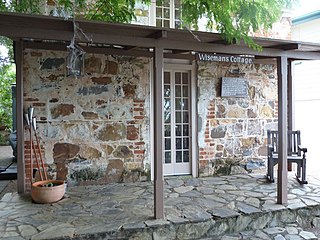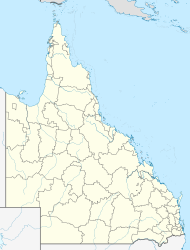
Rockhampton is a city in the Rockhampton Region of Central Queensland, Australia. The population of Rockhampton in June 2018 was 78,592, making it the fourth-largest city in the state outside of the cities of South East Queensland, and the 22nd-largest city in Australia.

Gracemere is a town and a locality in the Rockhampton Region, Queensland, Australia.

Westwood is a town in the Rockhampton Region and a locality split between the Rockhampton Region and the Shire of Banana in Queensland, Australia. It was the first town that was gazetted by the Queensland Government. In the 2016 census, Westwood had a population of 174 people.

Mount Archer is a suburb of Rockhampton and a mountain in the Rockhampton Region, Queensland, Australia. In the 2016 census, Mount Archer had a population of 85 people.

Rockhampton Airport is a major Australian regional airport in West Rockhampton that services the city of Rockhampton, with direct flights to the cities of Brisbane, and Mackay. Flights have previously operated to Sydney and Melbourne but were cancelled due to lack of passenger numbers. The airport runway has the capability to handle aircraft such as the A380, 747, & 777 types.

Rockhampton City is the central suburb of Rockhampton in the Rockhampton Region, Queensland, Australia. It is informally known as Rockhampton central business district (CBD).

The City of Rockhampton was a local government area in the Central Queensland region of Queensland, Australia, encompassing most of the suburban area of the regional city of Rockhampton. The city covered an area of 188.7 square kilometres (72.9 sq mi), and existed as a local government entity in various forms from 1860 until 2008, when it amalgamated with several other councils in the surrounding area to become the Rockhampton Region.

West Rockhampton is a suburb of Rockhampton in the Rockhampton Region, Queensland, Australia. In the 2016 census, West Rockhampton had a population of 1,825 people.

Allenstown is a suburb of Rockhampton, Rockhampton Region, Queensland, Australia. It is situated about three kilometres south-west of the central business district of Rockhampton. In the 2016 census, Allenstown had a population of 2,790 people.

Parkhurst is a suburb of Rockhampton in the Rockhampton Region, Queensland, Australia.

Bajool is a rural town and locality in the Rockhampton Region, Queensland, Australia. In the 2016 census, Bajool had a population of 455 people.

Gogango is a small town and a locality in the Rockhampton Region, Queensland, Australia.

St Mark's Anglican Church is a heritage-listed church at 36 Larnach Street, Allenstown, Rockhampton, Rockhampton Region, Queensland, Australia. It was built in 1900. It was added to the Queensland Heritage Register on 28 July 2000.

Wiseman's Cottage is a heritage-listed storehouse at 30 Nathan Street, The Range, Rockhampton, Rockhampton Region, Queensland, Australia. It was built from c. 1857 to c. 1859. It is also known as Mount Athelstane. It was added to the Queensland Heritage Register on 21 October 1992.

Park Avenue is a suburb of Rockhampton in the Rockhampton Region, Queensland, Australia.

The Caves is a rural town and locality in the Livingstone Shire, Queensland, Australia.

The Big Bulls are a set of seven large statues of bulls that decorate the city of Rockhampton, Queensland, Australia. The set is regarded as one of Australia's big things and is intended to reinforce Rockhampton's claim to being the Beef Capital of Australia. Initially there were two bull statues but over time others were added reaching a total of seven. Five of the bulls were created by sculptor Hugh Anderson.

Norman Gardens is a suburb of Rockhampton in the Rockhampton Region, Queensland, Australia.

Lakes Creek is a suburb split between Rockhampton Region and Shire of Livingstone, Queensland, Australia.

Fork Lagoons is a rural locality in the Central Highlands Region, Queensland, Australia. In the 2016 census, Fork Lagoons had a population of 0 people.











